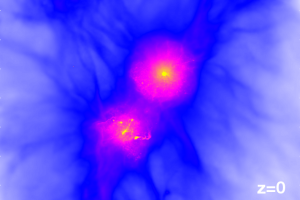We have just written a new paper, where we study the impact of reionization on galaxy formation in the Local Group using computer simulations.
We find that most of the dark matter halos of similar mass to the observed dwarf galaxies are in fact completely dark; unable to form stars after reionization heats up the intergalactic gas. Those halos that do form stars are not only rare, but also special: they formed much earlier than “typical” halos, and if they are satellites, they follow different orbits than a pure dark matter simulation would predict. We conclude that if we want to understand dark matter by only studying the halos that host the observable galaxies, we have to be aware that we are dealing with a very special selection. We call them The Chosen Few.

 From Fig. 1: Gas density in the Local Group simulation with reionization (left) and without reionization (right). Without reionization, many more “clumps” of gas can cool and form dwarf galaxies, but with reionization included, only a small fraction of low-mass halos keep enough cold gas for star formation, leaving most dark matter halos completely dark.
From Fig. 1: Gas density in the Local Group simulation with reionization (left) and without reionization (right). Without reionization, many more “clumps” of gas can cool and form dwarf galaxies, but with reionization included, only a small fraction of low-mass halos keep enough cold gas for star formation, leaving most dark matter halos completely dark.
If you’d like to read more, please take a look at our paper. Also, see Durham University’s press release.
Collaborators: Carlos S. Frenk, Azadeh Fattahi, Julio F. Navarro, Tom Theuns, Richard G. Bower, Robert A. Crain, Michelle Furlong, Adrian Jenkins, Matthieu Schaller, Joop Schaye

I read your recent paper on the Apostle Simulation.
http://arxiv.org/pdf/1511.01098.pdf
It seems that you are adding 2 eV of energy into the baryons at z=11.5.
However, this seems quite unfounded because recent data suggests that reionization occurred between z=8 and z=6. http://arxiv.org/pdf/1502.02024.pdf
How much does this assumption of energy addition into the baryons at z-11.5 affect your conclusions that lambdaCDM mimics local group properties quite well? Can lambdaCDM still mimic the local group if reionization doesn’t occur until between z=8 and z=6?
Hi Mike,
Great question! We tried different reionisation redshifts down to z=9, and the results are very similar. Of course, this is not the only parameter, and it’s quite feasible that there is still some important physical process missing from our simulations. However, at least in those aspects which we have studied, it looks like for this particular model, LCDM can indeed reproduce the LG observations.